In September 2019, MEDENT sold its 100th self-check-in kiosk. For about two years, these kiosks have been redefining the patient check-in process by ultimately reducing the time it takes a patient to reach the care they need. This case study provides insight on how MEDENT’s kiosks have improved a number of fronts including patient check-in times, collecting payments, and front desk efficiency to four different health practices. While these practices — Calvert Internal Medicine Group, G-Health Enterprises, and University at Buffalo Neurosurgery — differ from one another in various ways, each of them have seen similar results since they began using MEDENT’s kiosks.
As both patients and front desk staff know, traditional patient check-ins can take several minutes. Depending on the number of staff available to handle check-ins, a patient may have to wait in line before they can begin the actual check-in process. The kiosk can help eliminate these lines as patients can check in by scanning a driver’s license or a unique QR code that’s been delivered prior to an appointment. In addition to its check-in functionalities, the kiosk — compliant with the Health Insurance Portability and Accountability Act’s (HIPAA) privacy regulations — is also capable of completing other office tasks like collecting payments and prompting patients to complete any necessary paperwork.

As two of the first to sign on with MEDENT’s kiosks, the Greater Buffalo United Accountable Healthcare Network (GBUAHN) and Urban Family Practice — both entities of G-Health Enterprises in Buffalo, New York — have been granting their members access to this check-in technology for nearly two years. Between GBUAHN and Urban Family Practice, G-Health utilizes five MEDENT kiosks.
“The kiosk was a good add-on (for MEDENT), and it was executed well,” said Dr. Raul Vazquez, M.D., president and chief executive officer of G-Health Enterprises in October. “It’s a check-in tool, but that’s not what it really is. It’s really a way to make sure you’re completing a lot of tasks that are often missed.” G-Health in particular takes advantage of the kiosk’s ability to prompt patients to complete enrollment procedures.

Since March 2018, when kiosks first came to G-Health, the number of patients checking in via kiosk jumped by nearly 150% (surging from 1548 to 2310 at Urban Family and from 355 to 538 at GBUAHN). The average amount of time a patient spends in front of a kiosk also dropped. Urban Family saw check-in times reduce by 12 seconds while GBUAHN saw a 37-second reduction.
Another kiosk veteran, Calvert Internal Medicine Group in Maryland, saw similar results since it installed nine kiosks at three of its five locations in September 2018. After Calvert’s first operating month, 6728 check-ins were logged, averaging at 193 seconds per session. In October 2019, Calvert had logged 8383 kiosk check-ins, averaging at 63 seconds per session. Calvert had been using kiosks prior to signing on with MEDENT, so when MEDENT’s kiosks arrived, the patient learning curve wasn’t as drastic. However, the growth on both fronts was still significant. These two graphs to the right depict patient check-in progress derived directly from MEDENT’s kiosks. It’s important to note that each health practice differs in specialties and size. Some practices may have more kiosks than others, too. Nonetheless, these practices have managed to cut down check-in times while kiosk usage has continued to rise.
More than a check-in
Checking patients in for appointments can be seen as one of the kiosk’s primary functions, but at some practices like Calvert, the kiosk has evolved into a multipurpose tool. “Something unique about our practice is that we have an on-site lab in our Prince Frederick office,” said Lynne Thomas, Calvert’s Revenue Cycle Manager in September. “So, we allow patients to check-in through the kiosks as walk-in patients to have their bloodwork drawn. They can also check in for allergy injections and flu shots, too.”
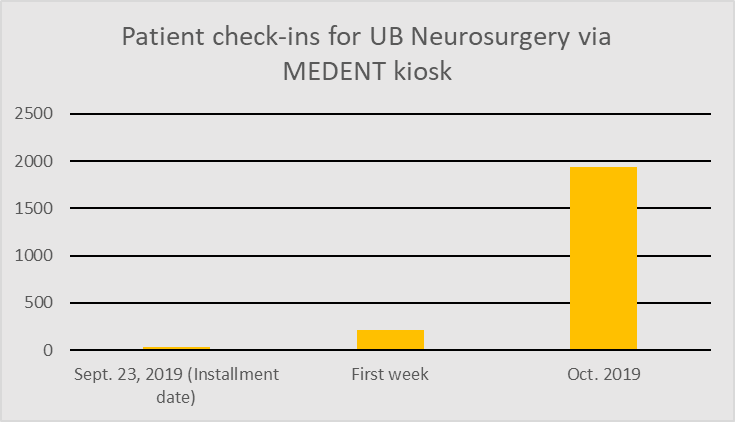
Recently, Calvert recalibrated its kiosks so that they’d prompt certain patients to complete an influenza consent form. “We give about 6,000 flu shots a year, and before we were using paper forms that we had to print, copy and scan,” Thomas said.
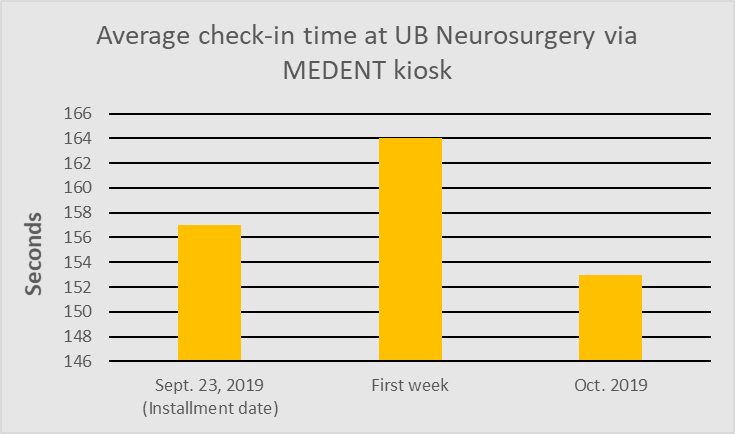
Checking a patient into an appointment is one thing. Getting that patient to complete paperwork is another. By combining the two tasks, health practices are able to get a jumpstart. Within MEDENT, office staff can use the Kiosk Summary Icon to see a log of each patient’s check-in, including whether the patient updated information, completed forms or made a payment. The practice can also set specific eSuperbill statuses to note when a patient has started and completed check-in using the kiosk.
Allison Adkison, who works with the First Impression Team at University at Buffalo Neurosurgery, helps patients check in on a daily basis. UB Neurosurgery recently constructed a new Williamsville facility, and even though the practice has only been using MEDENT’s kiosks since September 2019, Adkison has already noticed an impact they’ve made.
“The kiosks have helped us tremendously by starting the check-in process,” Adkison said in November. “Patients take a seat, we call them up and ask them if they have any fees or paperwork. The check-in process before for us was anywhere from five to six minutes, and now it only takes about maybe one minute.” Similar to G-Health and Calvert, Adkison highlighted the kiosk’s ability to prompt patients to complete paperwork. “It doesn’t give the patient an opportunity to complain about (paperwork) too much. It makes them do it. They can’t not do it. They can’t leave the forms in the waiting room, they can’t forget to bring them in. Patients are doing it within seconds at the kiosk.”
As shown in the graphs above, it took a couple weeks before patients really began taking advantage of UB Neurosurgery’s check-in kiosks. Because UB Neurosurgery hadn’t used kiosks prior to MEDENT’s, those first functioning weeks were educational. “Most patients know what they’re doing now, “Adkison said. “Every now and then, we’ll walk over with a patient and walk them through the check-in process a time or two to see if they have any questions. That way, the next time they come in, they don’t need any assistance.”
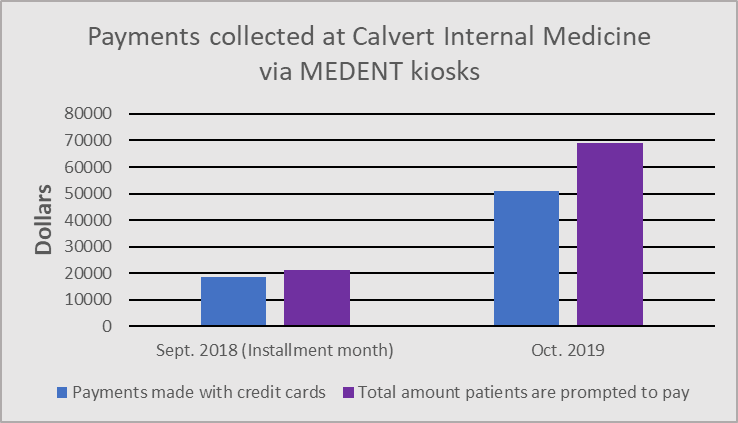
Like many other practices, UB Neurosurgery provides patients the option of making payments through the kiosk. Here’s how it works.
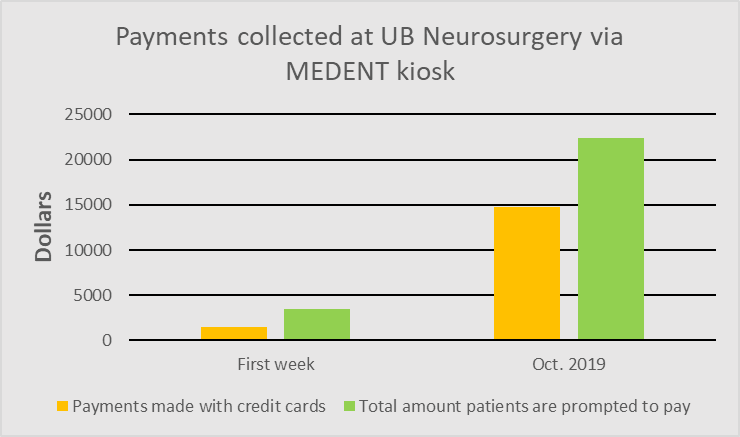
If a health practice chooses to enable the kiosk’s payment screen and signs on with a MEDENT partner’s credit card payment interface, the kiosk will prompt a patient to pay for their visit. Depending on which kiosk payment configuration a health practice selects, the kiosk can prompt a patient to pay some or all of their personal balance if one exists. If a patient wishes to pay with cash or check, the kiosk will direct them to an office’s front desk. A budget plan can also be programmed in, granting a patient more flexibility with their payments.
All credit card payments, as well as the total amount that patients are prompted to pay, are tracked by the kiosk. As an example, consider a practice that uses two MEDENT kiosks. Between the two kiosks, patients were prompted to pay $500; however, only $400 was collected in credit card payments. Both numbers are recorded and the remaining amount owed is then collected at the front desk. At Calvert and UB Neurosurgery, as illustrated in the graphs above, an overwhelming majority of payments made by patients are made with credit cards, which means an overwhelming majority of money owed is collected without any user intervention, right at the kiosk.
As the data indicates, MEDENT’s kiosks have reshaped patient check-ins. In short turnarounds, health practices have been able to cut patient wait times, complete paperwork, and efficiently collect payments, all with the help of the kiosk.
“Some people have said we’ve lost a bit of a personal touch (by using the kiosks), but I think when they understand the convenience of checking in on their own time and not waiting five or 10 minutes for someone to check them in, it goes a long way,” said James, Atwell, Calvert’s Operations Manager. “With the kiosks, patients can be checked in and seated in a room in a quick fashion … and you have to remember that the kiosk will never call out sick, so it will always be there.”


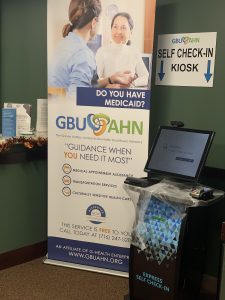

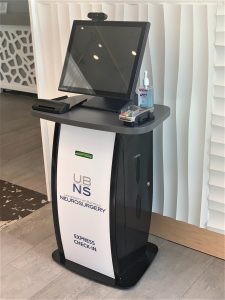
Comments are closed